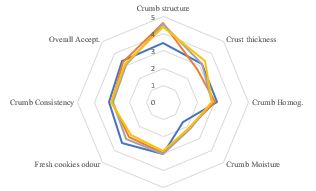Nutritional and sensory properties of cookies produced from flour blends of African walnut (Tetracarpidium conophorum), Justicia carnea and wheat
DOI:
https://doi.org/10.54117/iajnfms.v2i1.49Keywords:
Cookies, African walnut, Wheat, Justicia carnea, Proximate compositionAbstract
This study aims to evaluate the nutritional and sensory properties of cookies produced from flour blends of African walnut (Tetracarpidium conophorum), Justicia carnea and wheat. Walnut flour was used to substitute wheat flour while the Justicia carnea flour was used at a constant percentage as an enrichment in the ratio of (A) 100:00:0 (B) 88:10:2 (C) 78:20:2 (D) 68:30:2 of Wheat, walnut and Justicia carnea. Proximate composition of the cookies ranged between 0.65 – 1.45% for moisture, 2.15-2.80% for ash, 22.44 – 29.07% for fat, 9.19 – 11.25% for protein, 4.88 – 7.66% for crude fiber and 50.37 - 59.98% for carbohydrate. Moisture content decreased significantly (P 0.05) as walnut substitution increased while fat, protein, crude fiber and ash content increased as walnut substitution increased. The functional properties showed that water and oil absorption capacities ranged between 0.56 – 1.19 ml/g and 0.59 – 1.27ml/g respectively. Bulk density from 0.68 – 0.79ml/g, solubility and swelling power from 14.95 – 17.89% and 6.53 – 7.57g/g respectively. Mineral composition for Sodium, Potassium, Magnesium, Calcium and Phosphorus ranged between 465.16 – 507.29 mg/100g, 176.36 – 436.36mg/100g, 16.60 – 89.86mg/100, 23.69 – 60.80mg/100g and 9.40 – 11.40mg/100g respectively. Sodium, Potassium, magnesium and Phosphorus contents increased significantly (P<0.05) while Calcium decreased with increase in walnut flour substitution. The physical properties ranged between 0.50 – 0.60cm, 5.45 – 5.50cm and 9.16 -10.80cm for height, diameter and spread ratio respectively. Only sample D showed significant increase (P<0.05) in spread ratio. Sensory scores showed crumb colour, crust thickness, crumb homogeneity, crumb moisture, crumb cohesiveness, fresh cookies odour, crumb consistency and overall acceptability reduced with increase in walnut flour. The study revealed that nutritious and acceptable cookies could be produced from addition of African walnut and Justicia carnea flour blend.

Downloads
Published
How to Cite
Issue
Section
License
Copyright (c) 2024 Udedeh H. Emem, Nkechi J. T. Emelike, Chinasa Okorie-Humphrey, Chukwunwike Uchenna Enyi

This work is licensed under a Creative Commons Attribution 4.0 International License.
